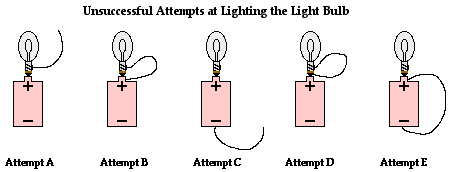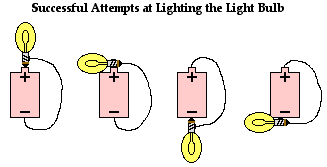Electric Feel


In this project, I am going to be exploring electricity following the 5-Es Lesson Plan. This format is an instructional model that describes 5 phases of learning with each phase represented with the letter "E": Engage, Explore, Explain, Elaborate, and Evaluate.
Engage
You and some friends decide to go spelunking in Linville Caverns. The cave is peaceful and quiet, so you decide to wander off for a bit. You sit for awhile in the dark and listen to the sound of water dripping from the stalagmites and screeching of bats. Your friend's call reverberates off of the cavern walls. As you stand to leave, CRASH! Your head hits the top of the cave. You feel around in the darkness and find some wires and a bulb. You call out, but no one answers. Can you fix your light to make it out of the cavern?
Explore
This is your hook! The part of the lesson that is going to get your students engaged and curious about what you're about to teach. It could be a story, a problem or a hands on activity.

In this section, students are given two wires, a battery and a light bulb. The object of the activity: make the light bulb light up. Allow students to work together and problem solve. Ask them to take notes about what doesn't work and what does work as well as draw diagrams. I worked with a partner to figure this out. It took us about 10 minutes and some hints from our professor Jeff Goodman to finally get the bulb to light up. We figured out that in order to make it light up, we needed to touch both ends of the battery and two parts of the metal in the bulb to make it light. Here are some pictures and notes that we took of this process.
This is the section where you allow your students to investigate in groups or individually with hands on activities.









Questions to ask students as they work
-
Are any of the parts getting hot? If so, what do you think is happening? (Think back to what you know about energy transfer.)
-
Where are the wires touching the light bulb when it lights up?
-
If you can get it to light up with two, can you do it with one?

Key Concepts
-
Conductor- a material that an electric current (a bunch of electrons) can pass through. Ex: metal
-
Insulator- a material that does not all an electric current to pass through it. Ex: plastic
-
Battery- a battery is an electron pump. The battery has stored energy that is used to create an electrical current.
-
Light bulb- a light bulb is an object that produces light by allowing electrons to move through the filament (which is a conductor).
-
Switch- the switch can either stop or start the flow of electrons through the circuit.
-
Closed circuit- this is an uninterrupted circular path in which the electrons or electric current can flow.
-
Open circuit- this is an incomplete circuit and thus the electrons cannot travel.
-
Short circuit- a short circuit occurs when there is no device for the electrons to travel through so they build up and as a result release a lot of heat. This is why houses have circuit breakers because if this happens, the power turns off to protect from fire.
Explain
This is the part of the lesson where you work with your students to make sense of the hands activity that they found in the "Explore" portion and associate official vocabulary and concepts that you want them to learn. Ask students to discuss vocabulary with one another and see if they can define it together.


Some examples of what a student's process could look like. I do not claim the rights to these photos.
Expand
In this section, students build upon the information that they have learned previously to new concepts.
In my case, I decided to explore Snap Circuit kits in the Instructional Materials Center from 11:45am-1:45pm on 04/19/17 with my little sister Bethany to expand on what I had learned. We had a blast configuring circuits that made noise, lit up and had motors.
This kit may be too easy for some students. In this case, I would recommend something more complex such as littleBits. Note that just allowing your students to play with these kits without elaboration of content and vocabulary will lead to them having fun, but not gaining mastery of the material; vice versa is also true.
Interested in what others had to say about this product, check out these reviews.









Note: If you ask your little sister not to do something, expect for her to immediately do what you told her not to do
Evaluation
Now it is time to evaluate how your students have absorbed and applied the information that they have learned. This gives the teacher information about where the students are and how to alter the lesson to better fit their needs. Evaluation does not have to be in standard written or test form. For example, you could have students choose a lesson of their choice to build from the littleBits educator website and explain using content vocabulary. You could also have students draw an example of a circuit that includes a switch, light bulb, wire and battery. Make sure that they label and trace the path of electrons in their circuit. Teachers can also evaluate content by asking questions. Below are some sample questions with potential student answers.

Questions
1. What happens if there is a gap in the circuit? What is this called?
Electrons cannot flow because they don't have a path to a conductor. It is called a open circuit.
2. What materials allow electrons to flow? What materials do not?
Conductors let electrons flow. An example of this would be iron, copper or steel. Insulators do not let electrons through. Materials like these would be glass, wood and felt.
3. When we want to turn on a light, we flip a switch. What do you think the switch is doing?
When we turn a switch on, the light switch closes the circuit and gives the electrons a path to flow through.
4. What is a complete path that electricity can move through called? Give an example of a closed circuit that you built today.
A closed circuit. I built a closed circuit when I made the light bulb light up with the wires and batteries. I knew that it was closed because all the materials were touching and the light meant that electricity was flowing.
